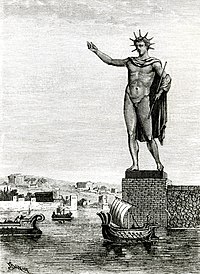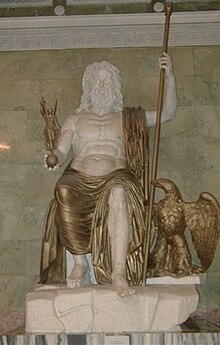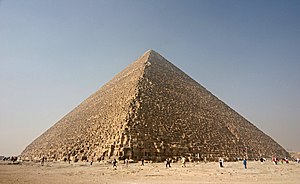sábado, 28 de agosto de 2010
LIGHTHOUSE OF ALEXANDRIA
 The Lighthouse of Alexandria, also knoun as the Pharos of Alexandria, was a tower built between 280 and 247 BC on the island of Pharos at Alexandria, Egypt to guide sailors into the harbour at nught. With a height variously estimated at between 393 and 450 ft, it was for many centuries among the tallest man-made structures, and was one of the Seven Wonders of The Ancient World.
The Lighthouse of Alexandria, also knoun as the Pharos of Alexandria, was a tower built between 280 and 247 BC on the island of Pharos at Alexandria, Egypt to guide sailors into the harbour at nught. With a height variously estimated at between 393 and 450 ft, it was for many centuries among the tallest man-made structures, and was one of the Seven Wonders of The Ancient World.Pharos was a small island just off the coast of Alexandria, which was connected to the mainland by a man-made causeway named the Heptastadion, which formed on side of the city´sharbor. The tower erected on the island guided mariners at night using fire and reflective mirrors, and acted as a landmark by day. It was said that the light could seen from up to 29 miles away, and legends claim that he light from Pharos could burn enemy ships before they reched shore.
DESCRIPTION:
Constructed from large blocks of light-coloured stone, the tower was made up of three stages: a lower square section with a central core, a middle octogonal section,and, at he top, a circular section. At its apex was positioned a mirror which reflected sunlight during the day; a fire was lit at night. Extant Roman coins struck by the Alexandrian mint show that a statue of a triton was positioned on each of the building´s four corners. A statue of Poseidon, stood atop the tower during the Roman period. The Pharo´s masonry blocks were interlocked, sealed together using molten lead, to whitstand the pounding of the waves.
COLOSSUS OF RHODES
 The colossus of Rhodes was a statue aof the Greek god Helios, erected in the city of Rhodes on the Greek island of Rhodes by Chares of Lindos between 292 and 280 BC. It is considered one of the Seven Wonders of the Ancient World. Before its destruction, the Colossus of Rhodes stood over 30 meters high, making it ne of tallest statues of the ancient world.
The colossus of Rhodes was a statue aof the Greek god Helios, erected in the city of Rhodes on the Greek island of Rhodes by Chares of Lindos between 292 and 280 BC. It is considered one of the Seven Wonders of the Ancient World. Before its destruction, the Colossus of Rhodes stood over 30 meters high, making it ne of tallest statues of the ancient world. POSTURE: The harbor-straddling Colossus was a figment of medieval imaginations based on the dedication text´s mention of "over land and sea" twicw. Many older illustrations show the statue with one foot on either side of the harbor mouth with ships passing under it "... the brazen giant of Greek fame, with conquering limbs astride from land to land", a poem engraved on a bronze plaque and mounted inside the statue of Liberty in 1903.
LOCATION OF THE RUINS:
Media reports in 1989 initially suggested that large stones found on the seabed off the coas tof Rhodes might have been the remains of the Colossus ; however this teory was later shown to be without merit.
REBUILDING:
There has been much debate as to whether to rebuild the Colossus. Those in favor say it would boost tourism in Rhodes greatly, but those against construction say it would cost too large an amount (over 100 million euro). This idea has been revived many times since it was first proposed in 1970 but, due to lack of funding, work has not yet started.
miércoles, 25 de agosto de 2010
MAUSOLEUM OF MAUSSOLLOS AT HALICARNASSUS

The mausoleum at Halicarnassus or Tomb of Mausolus, was a tomb built between 353 and 350 BC.It stood approximately 45m in height, and each of the four sides was adorned with scuptural relifies created by each one of four Greek sculptors.The word mausoleum has since come to be used generically for any grand tomb.
HALICARNASUS: Mausolus decided to build a new capital; a city as safe from capture as it was magnificent to be seen. He chose the city of Halicarnasus. If Mausolus ships blocked a small channel, they could keep all enemy warships out.
CONSTRUCTION: The tomb was erected on a hill overlooking the city. The whole structure sat in an enclosed courtyard.At the center of the courtyard was a stone plataform on which the tomb sat.A stairway flanked by stone lions led to the top of the platform, which bore slong its outer walls many satatues of gods and goddess
TEMPLE OF ARTEMIS AT EPHESUS

The temple of artemis, also known less precisely as Temple of Diana, was a Greek Temple dedicated to a goddess Greks identified as Artemis that was completed, in its most famous phase, around 550 BC at Ephesus. Though the monument was one of the Seven Wonders of The Ancient World, only foundations and sculptural fragments of the temple remain. There were previous temples on its site, where evidenceof a sanctuary dates as early as the Bronze Age. The whole temple was made of marble except for the roof.
The temple antedated the lonic inmigration by many years.The Temple of Artemis was located near the ancient city of Izmir, in Turkey. Today the site lies on the edge of the modern town.
ARCHITECTURE AND ART:
Most of the physical description and art within the Temple of Artemis comes from Pliny though three are different accounts, and the actual size varies.Pliny describes the tempe as 377 feet long and 180 feet wide, made almost entirely of marble, making its area about three times as large as the Parthenon.
STATUE OF ZEUS AT OLYMPIA

The statue of Zeus at Olympia was made by the Greek sculptor Phidias, circa 432 BC on the site where it ewas erected in the Temple of Zeus, Olympia, Greece. The seated statue, some 12 meters tall, occupied the whole width of the aisle of the temple built to house it. The sculpture was wreathed with shoots of olive worked in gold and seated on a magnificent throne of cedarwood.
The date of the statue, in the third quarter of the fifth century BC, long a subject of debate, was confirmed archaeologically by the rediscovery and excavation of Phidias workshop. The sculptor also was reputed to have inmortalised his eromenos, Pantarkes, by carving " Pantarkes Kalos", into the god´s little finger, and placing a relief of the boy crowning himself at the feet of the statue.
THE HANGING GARDENS OF BABYLON
The Hanging Gardens of Babylon are considered to be one of the original Seven Wonders of the Ancient World. They were bilt in the ancient city-state of Babylon, near present-day Al Hillah, Babil, in Iraq. The gardens were built by the Babylonian king Nebuchadnezzar II around BC.
Through the ages , the location may have been confused with gardens that existed at Nimrud, since tablets from there clearly show gardens. Writing on these tablets describe the possible use of something similar to an Archimedes Screw as a process of raising the water to the required height.
CONTROVERSY:
There is some controversy as to whether the Hanging Gardens were an actual creation or a poetic creation due to the lack of documentation of them in the chronicles of Babylonian history. In ancient writings the Hangong Gardens of Babylon were first described by Berossus, a Babylonian priest who lived in the late 4th century BC. These accounts were later elaborated on by Greek historians.
GREAD PIRAMID OF GIZA

The great pyramid is the oldest and largest of the three pyramids in the Giza Necropolis bordering what is now El Giza Egypt. Is the oldest of the Seven Wonders Of The Ancient World, and the only one to remain largely intact. The pyramid was built as a tomb for Fourth Dinasty Egyptian.
The Great Pyramid was the tallest man-made structure in the world for over 3.800 years. There are three known chambers inside the Greta Pyramid. The main part of the Giza complex is a setting of buildings that included two mortuary temples in honor of Khufu, three smaller pyramids for Khufu´s wives, an ever smaller "satellite" pyramid, a raised causeway connecting the two temples, and small mastaba tombs surrounding the pyramid for nobles.
ENRANCE:
Today tourists enter the Great Pyramid via the Robber´s Tunnel dug by workmen employed by Caliph al-Ma´mun around AD 820. The tunnel is cut straight through the masory of the pyramid for approximately 27 metres, then turns sharply left to encounter the blocking stones in the Ascending Passage. Unable to remove these stones, the workmeng tunnelled up beside them through the softer limestone of the Pyramid until they reached the Ascending Passage. It´s possible to enter the Descending Passage from this point, but access is usually forbidden.

Made by: Luisa Gamez, Alejandra Calderon, Camila Moreno, Aura Hernandez y Natalia Ramos
Suscribirse a:
Entradas (Atom)